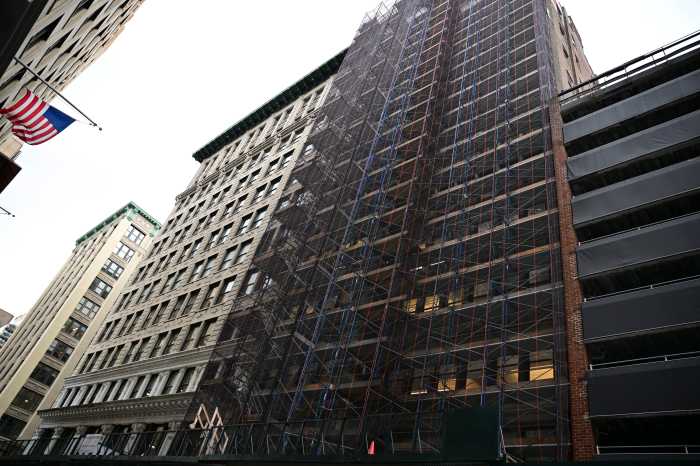Assemblyman and Democratic Nominee Zohran Mamdani Mamdani said his administration would prioritize efficiency on city-owned properties to lead by example and encourage private building owners to follow suit.
Photo by Lloyd Mitchell
Democratic mayoral nominee Zohran Mamdani on Monday unveiled a sweeping plan to reduce the number of sidewalk sheds across New York City, pledging to remove all city-owned scaffolding that has been up for more than three years and to overhaul the city’s approach to building maintenance and facade inspections.
The proposal aimed at dismantling what Mamdani called the city’s “concrete jungle gym” was unveiled during a Oct. 20 press conference in Union Square alongside Manhattan state Sen. Brad Hoylman-Sigal, Borough President Mark Levine, and City Council Member Keith Powers.
According to city data, more than 8,500 scaffolding structures currently line New York’s streets, most of them in Manhattan. The average structure has been in place for over 500 days, and roughly 370 have stood for more than five years.
“If you put those sidewalk sheds on the highway, they would stretch from New York City to Albany to Buffalo to Montreal and beyond,” Hoylman-Sigal said, calling scaffolding both a public safety and an economic issue that burdens small businesses and blights neighborhoods.
Mamdani criticized outgoing Mayor Eric Adams who in April signed a five-bill legislative package giving the Department of Buildings (DOB) expanded authority to push property owners to complete building repairs more quickly and remove sidewalk sheds once work is done, charging that Adams had only succeeded in removing fewer than 400 sheds. City Hall to not respond to request for comment on Mamdani’s accusation.
“I want to succeed where he failed,” Mamdani said, “and I want to build on the legislation that Council Members Powers and [Erik] Bottcher shepherded through to actually bring light back into New Yorkers’ lives.”
He continued: “We are going to remove all sheds that have been up longer than three years on city property. It’s time for the city to show itself as the leader in this fight. There are hundreds of sidewalk sheds within our control as city government that we can bring down — and my administration will do that.”
If elected, Mamdani’s plan includes several key components aimed at modernizing and reducing the city’s reliance on scaffolding. It calls for the immediate removal of all city-owned sidewalk sheds that have been up for more than three years, with Mamdani pledging to “aggressively fund and repair” the affected buildings.
The proposal would also extend the facade inspection cycle for newer structures under Local Law 11 from five to ten years, which Mamdani said is appropriate for buildings with “more modern engineering and lower risk.”
In addition, he plans to implement new “safer, brighter, and airier” scaffolding designs based on an ongoing DOB’s study, and to reorient the Office of Management and Budget to prioritize preventive maintenance funding for city buildings—reducing the need for scaffolding in the long run.

The initiative drew support from a coalition of elected officials, including Powers, the outgoing City Council member who had sponsored three of the five bills previously signed into law by Adams.
Powers said the issue has burdened neighborhoods for too long, particularly the small business “buried underneath them.”
“One thing New Yorkers universally agree on, we want scaffolding down,” Powers said. “When I was running for office, I met a small business owner whose coffee shop sat under scaffolding that blocked visibility and foot traffic.”
“It’s our neighborhoods that are unsafe and dimly lit because of the existence of them, it’s buildings that are struggling with the financial constraints of trying to live under this very rigid Local Law 11,” Powers said of the decades of law which requires landlords to inspect their building facades every five years and erect sidewalk sheds during each inspection.

Levine, the Democratic nominee for City Comptroller, noted that the city’s scaffolding laws date back nearly 50 years, to the 1979 death of 17-year-old Barnard student Grace Gold, who was struck by falling masonry on Broadway and 115th Street.
“That tragedy led to laws regulating facade repairs and the scaffolding meant to protect pedestrians,” he said. “Nearly half a century later, it’s time for an update. We now have thousands of sidewalk sheds clogging our streets.”
→ Continue reading at amNY
